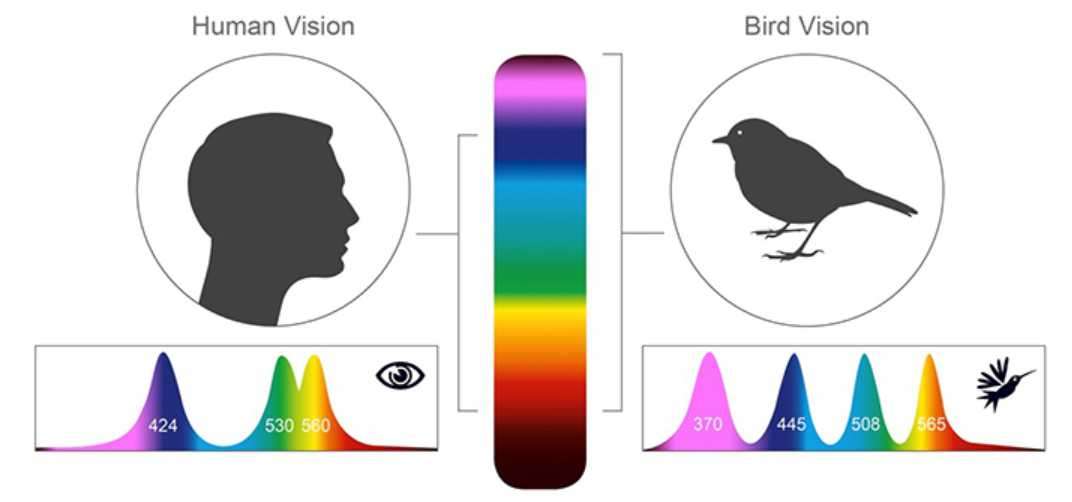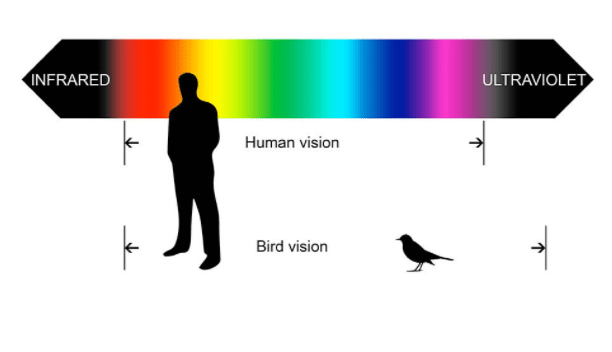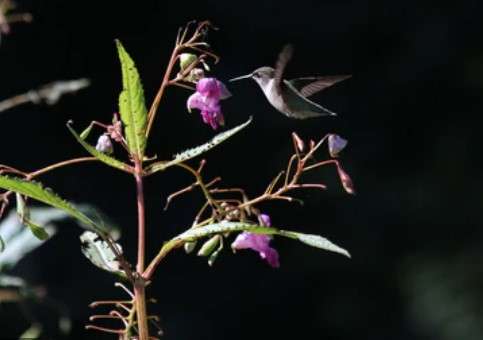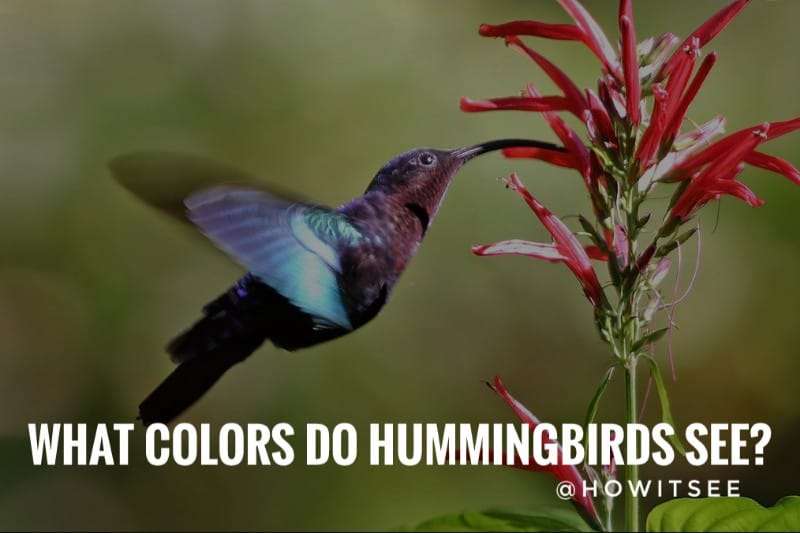Hummingbirds are one of the smallest bird species on the planet. With many strange facts associated with it, hummingbirds have always remained a subject of wonder. These nectar-feeding birds are often seen hovering around bright, beautiful flowers, looking for their food. This habit of theirs, flocking around brightly colored flowers, raises a question, What colors do hummingbirds see? Therefore, let’s take a dig into today’s article, What Colors do Hummingbirds see? Hummingbird vision with Colors Explained. So, without much ado, let’s get into our article.
To answer this question; Hummingbirds have colored vision, just like humans, and are better than us in terms of colored vision. Their vision is spread through a wide spectrum. Besides general colors and shades from the visible spectrum, they can also see non-spectral lights from the near-ultraviolet region. They can perceive shades that we, humans, cannot perceive. More about hummingbird’s vision has been discussed vividly in the segments below.
What colors do Hummingbirds see?
Humming Birds have a colored vision. They can see almost every color from the visible spectrum and its shades, amounting to hundreds of color combinations. These include red, blue, indigo, green, orange, and even extend to purple.

Credits | Klaus Schmitt
Apart from this, they can even see near UV or non-spectral colors, which include UV green, UV red, UV purple, UV yellow, etc. These colors stand out from other colors due to their brightness and attract hummingbirds.
For vision and light perception, the optical cells that play a major role are cone cells. These cells lie in the retina of the eye and are responsible for color perception.
Humans have three cone cells, while birds have four. Apart from the L-cones, M-cones, and S-cones, birds have additional cone cells that help them to perceive UV rays.

Credits | Bird Academy
Hummingbirds are nectar feeders and have an enormous role in cross-pollination. Flowers need to be attractive to attract hummingbirds to feed on their nectar and hence, pollinate them.
These 4th cone cells help them to perceive a highly attractive combination of normal colors like green and red in combination with UV.
These non-spectral colors are highly attractive to hummingbirds, which are generally invisible to other colored vision animals, like humans. The color vision in hummingbirds even exceeds that of humans.
What colors are Hummingbirds attracted to?
Bright, vibrant colors are essential hummingbird attractors. Therefore, colors like Red and Yellow attract them the most. Even orange attracts them to quite an extent.
Therefore, though they are attracted to other colors from the visible spectrum, like blue and green, colors like Red and Yellow are given more preference than the others.

It has been observed and proven that hummingbirds are hugely attracted to bright warm colors, especially red. There is an entire chain of processes that come into play while determining which colored plants will attract hummingbirds.
Hummingbirds, like many others, possess something which we know as double-cone. These are electrically paired cone cells bearing the pigment, which is responsible for sensing particularly long-wavelength light.
These double cones have a layer of photoreceptor oil droplets, which further enhances their ability to distinguish colors. Humming birds’ vision works at its peak in the wavelength range of 520-580 nm.
In nature, hummingbirds compete with insects like bees, who also feed on nectar. The red color is not perceived by bees. As a result, red color flowers are often overlooked by bees, making them nectar abundant, on which hummingbirds feed.
Therefore, red-colored flowers will, by default, have a high probability of being abundant in nectar. Hence, naturally, Hummingbirds get attracted to red flowers.
What colors do Hummingbirds not like?
There aren’t any particular colors that hummingbirds do not like. Among the several colors in the visible spectrum, there are a few that they are attracted to more than the others.
While hummingbirds have an affinity toward red, and yellow to some extent, colors lying on the other end of the visible spectrum, like blue and its shades, do not attract hummingbirds.
In the visible spectrum of light, blue and its shades have the least wavelength, while red has the most. As aforesaid, Hummingbirds have an affinity towards red, as they have their double cones with long-wavelength sensing pigment.
Colors like blue, purple, indigo, etc., are least attractive to Hummingbirds. So, though there aren’t any colors that Humming Birds do not like, there are colors like Blue, Indigo, or Purple that they do not find attractive.
Can Hummingbirds see in the Dark? Hummingbird Night Vision
Hummingbirds primarily feed in the morning, and before it gets dark, they return to their perching site and settle down. As an answer to the question, Hummingbirds can see in the dark.
This is evident from the fact that some species are migratory, and they fly at night. Though their night vision is not as good as other birds like owls, they can see in the dark to quite an extent.

Credits: Wingspan Optics
The cells responsible for night vision are rod cells. These cells lie in the retina of the eye. Hummingbirds have rod and cone cells in their eyes, in greater numbers than humans. Therefore they can see in the dark.
However, they are daytime feeders and do not need to use their night vision. Some Hummingbird species are migratory, and they use their night vision during flight.
Under normal conditions, if they are seen flying around at night, it might be under artificial lighting conditions. However, under dark pitch conditions, they may not see anything.
How good is a Hummingbird’s eyesight?
Hummingbirds have excellent eyesight. They possess four types of light-sensing cones and can perceive colors from which we humans are blinded. This ability helps them to feed in nature.
Hummingbirds have their eyes on the side of their heads. This gives them a wide peripheral vision (nearly 360 degrees), which is highly essential for these fast-flying birds to prevent collisions, and for detection of predators.
The binocular vision range is quite small (nearly 30 degrees), which further increases the field of view. They can perceive near UV colors, like UV + red and UV + green, which are almost impossible for Humans to detect.
They can also see far-off objects using their central fovea, which helps to look for foraging centers. So researchers claim them to see distances farther than what human vision can perceive.
They can also see close-range objects, which helps them to maneuver in dense areas. The extremely narrow blind spot in their vision comes of great help, as hummingbirds often fall prey to other birds, bird-eating spiders, etc.
The sense of vision and processing of the changes in the surroundings by stimuli is so sharp in hummingbirds that, at such high flight speed, even a slight change will cause the bird to react to it quickly.
Hummingbird vision vs Human vision
| Hummingbird Vision | Human Vision |
| 1. Hummingbirds show Tetrachromancy. They have four cone cells, L-cones, M-cones, S-cones, and the 4th one for UV perception. | 1. Humans show Trichromancy. They have only three cone cells, L-cones, M-cones, and S-cones. |
| 2. They can see Ultraviolet Light. | 2. Humans cannot perceive Ultraviolet Light. |
| 3. Hummingbirds can see non-spectral colors, like purple, UV + red, UV + yellow, UV purple, UV green, etc. | 3. Humans can only perceive colors from the visible spectrum region, and no non-spectral colors are visible. |
| 4. The binocular vision in hummingbirds is extremely small, nearly 30 degrees. | 4. In humans, binocular vision is predominant, and gives as much as 130 degrees of field view, on each one. |
| 5. Hummingbirds have electrically paired cone cells, with pigments that help them to perceive long-wavelength lights better. | 5. In humans, there are no such structures as double cones, and only three types of cone cells are present. |
We now come to the end of our today’s article titled, “What Colors do Hummingbirds see? Hummingbird vision with Colors explained.” We will be returning soon with another interesting topic. Until then, read the FAQ section mentioned below. It will enhance your knowledge.
Frequently Asked Questions:
Q1. What color flowers do hummingbirds like best?
Ans. Hummingbirds like flowers with bright colors, most of the color Red. However, they also prefer flowers of the colors yellow and orange.
Q2. Can hummingbirds see ultraviolet light?
Ans. Yes, hummingbirds can see ultraviolet light and even near UV light. Near UV light implies UV light in combination with other colors like red, green, yellow, etc.
Q3. Can hummingbirds see red?
Ans. Yes, hummingbirds can see red, and it is their most preferred color. Red color attracts hummingbirds to the most extent.
Q4. How far can Hummingbirds see?
Ans. Hummingbirds are quite far-sighted creatures. Certain studies claim them to see distances greater than what humans can see.
Did you know?
- On average, a hummingbird flaps its wings 80 times per second! This number may occasionally even reach as many as 200 flaps per second.
- Hummingbirds are the only birds on the planet with the ability to fly backward.
- They have the largest brain in proportion to body weight and account for over 4.2% of it.
Also Read:

Meet Monty, the visionary founder of How It See, being an engineering student, he’s fueled by an insatiable curiosity about the world around him. He is captivated by an eclectic correlation between animal groups, science, and nature, and this fascination drives his quest for understanding.
After completing his degree, he’s set on a mission to delve deep into the realm of nature, accumulating knowledge to share with you through his writing. In the meantime, he loves to watch anime and read anime.

